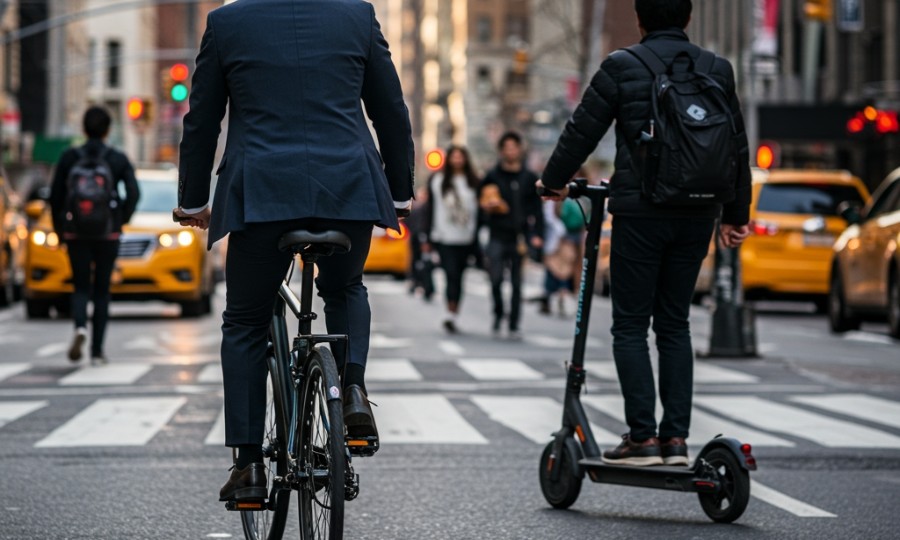
Ever feel like e-bikes and e-scooters are absolutely everywhere in New York City? You’re not imagining it. These convenient electric vehicles have truly exploded in popularity, offering a quick way to zip through traffic or make deliveries. But with this surge in usage, we’re also seeing a concerning rise in e-bike and e-scooter accidents. It’s a complex issue, isn’t it? As a city always on the move, NYC presents unique challenges for integrating these fast-moving devices safely. We’re not just talking about minor fender benders; serious injuries are becoming more common for riders, pedestrians, and even drivers. You might wonder, what’s being done about it? And more importantly, what should you know to protect yourself?
Here’s the thing: navigating the urban jungle on or around e-bikes and e-scooters requires a fresh understanding of the rules, risks, and responsibilities. The legal landscape is constantly evolving, with new state laws directly impacting how accidents are reported and what happens afterward. This article isn’t just about the statistics; it’s about empowering you with the knowledge to stay safer and understand your options if an accident does occur. We’ll explore the current trends, delve into the new legal requirements, and share crucial safety insights for everyone sharing NYC’s streets and sidewalks.
The E-Vehicle Boom: Convenience Meets Urban Challenge
New York City has always been a hub of innovation, and the rapid adoption of e-bikes and e-scooters perfectly illustrates our city’s embrace of new transportation solutions. From food delivery services relying heavily on e-bikes to commuters opting for e-scooters to beat subway delays, these vehicles offer undeniable advantages. They’re environmentally friendlier than cars, often faster than walking, and can be more affordable than traditional public transport for short distances. But, as with any rapid change, there are growing pains. The sheer volume of these vehicles, often operating at higher speeds than traditional bicycles, has created new dynamics on our crowded streets and bike lanes. We’re talking about devices that can easily hit 20-30 mph, sometimes silently, which can be startling for pedestrians and other road users.
The numbers speak for themselves. The New York City Department of Transportation (NYC DOT) and NYPD data have consistently shown an uptick in collisions involving e-bikes and e-scooters. You don’t have to look far to see evidence of this; a quick glance at local news reports often features stories of accidents at busy intersections or on shared paths. This rise isn’t just a perception; it’s a documented trend that city officials and safety advocates are actively working to address. The challenge lies in balancing the convenience these vehicles offer with the critical need for public safety. It’s a tightrope walk, wouldn’t you agree?
New York’s Evolving E-Vehicle Laws: Staying Up-to-Date
For a while, the legal status of e-bikes and e-scooters in New York was a bit of a gray area, leading to confusion and, frankly, some dangerous situations. Thankfully, the state has made significant strides in clarifying these regulations. In 2020, New York State officially legalized the use of throttle-powered e-bikes and e-scooters, categorizing them based on their speed and motor power. This was a huge step, bringing much-needed clarity for riders and law enforcement alike. For instance, most common e-bikes for delivery fall into Class 1 (pedal-assist, max 20 mph) or Class 2 (throttle, max 20 mph), while Class 3 e-bikes (pedal-assist, max 28 mph) are restricted in some areas. E-scooters typically have a maximum speed of 20 mph.
The critical takeaway here is that these aren’t just toys; they’re legitimate motor vehicles under New York law, even if they don’t require registration or traditional licenses in the same way cars do. This distinction is crucial because it influences everything from where you can ride them to your responsibilities if you’re involved in an accident. You might be thinking, “What about helmets?” Generally speaking, riders under 14 must wear a helmet on any bicycle, and for Class 3 e-bikes, riders under 17 must wear one. While not always legally mandated for adults on Class 1 or 2 e-bikes or e-scooters, wearing a helmet is always a smart choice (and one I strongly recommend, personally).
Accident Reporting is Now Mandatory: Why This Matters for Everyone
Perhaps one of the most significant recent developments impacting e-bike and e-scooter safety in New York came into effect with amendments to the Vehicle and Traffic Law (VTL). As of June 2023, New York State now requires the reporting of all traffic accidents involving e-bikes and e-scooters that result in death, personal injury, or property damage exceeding $1,000. Before this, many such incidents went unreported, making it difficult to get a clear picture of the true scope of the problem. This new mandate is a game-changer.
Why is this so important? Well, for starters, accurate data is essential for developing effective safety policies and infrastructure improvements. If city planners don’t know where accidents are happening most frequently, how can they effectively implement changes like better bike lanes or improved signage? This reporting requirement also directly impacts individuals involved in collisions. If you’re injured in an e-bike accident, for example, having an official police report detailing the incident can be absolutely critical for any subsequent legal or insurance claims. It provides an objective record of what happened, who was involved, and the immediate consequences. We know this feels overwhelming, especially in the moments after a crash, but understanding this requirement is a vital first step.
Crucial Safety Tips for Riders and Pedestrians Alike
Whether you’re riding an e-bike, scooting on an e-scooter, walking the sidewalk, or driving a car, safety is a shared responsibility. Let’s talk about some practical ways to minimize risks. For riders, the basics are non-negotiable: wear a helmet, always obey traffic laws (stop signs, traffic lights), and use appropriate hand signals. You’d be surprised how many riders disregard these fundamental rules, putting themselves and others in jeopardy. Visibility is also key, especially at night. Invest in good lights, reflective gear, and bright clothing. Don’t weave through traffic or ride against it. And please, resist the urge to ride on sidewalks, which is illegal in most areas of NYC for e-bikes and e-scooters and incredibly dangerous for pedestrians. Always yield to pedestrians; they have the right of way.
For pedestrians, while you might feel less in control, awareness is your best defense. Put away your phone, look both ways (multiple times!), and make eye contact with riders and drivers. Assume e-vehicles might be moving faster than you expect, and remember they can be surprisingly quiet. Cross at designated crosswalks, even if it adds a few extra steps. If you’re walking with children, teach them about road safety and the unique challenges posed by e-vehicles. It’s about being proactive, not just reactive, in our bustling city environment. You might be thinking this won’t work because everyone’s always distracted, but even small changes in personal vigilance can make a big difference.
Navigating the Aftermath: What to Do After an E-Vehicle Accident
Despite our best efforts, accidents can happen. If you find yourself involved in an e-bike or e-scooter collision, knowing what steps to take immediately afterward can significantly impact your long-term outcome. First and foremost, check for injuries – your own and anyone else involved. If someone is hurt, call 911 immediately. Even if injuries seem minor, it’s always better to get medical attention. Next, move to a safe location if possible, away from traffic.
Remember that new reporting requirement? Call the police to the scene to ensure an official accident report is filed, especially if there are injuries or significant property damage. Document everything: take photos of the scene, vehicle damage, injuries, and any relevant road conditions. Get contact and insurance information from all parties involved, including any witnesses. Don’t admit fault, even if you think you might be partially to blame; let the authorities and insurance adjusters determine that. Finally, seek legal counsel. An attorney experienced in New York personal injury law, particularly with e-vehicle accidents, can help you understand your rights, navigate insurance claims, and ensure you receive proper compensation for medical bills, lost wages, and other damages. It’s a complicated process, and you don’t have to go through it alone.
The rise of e-bikes and e-scooters has undoubtedly transformed urban mobility in New York City. While they offer fantastic convenience, they also introduce new safety challenges that demand our attention. By understanding the evolving laws, prioritizing safety, and knowing what to do in the event of an accident, we can all contribute to making our streets safer for everyone. Stay informed, stay vigilant, and let’s ride (or walk) responsibly.
Free Case Consultation
Injured in an accident? Contact Rosenberg, Minc, Falkoff & Wolff for a free and confidential case review with an experienced NYC personal injury attorney.


